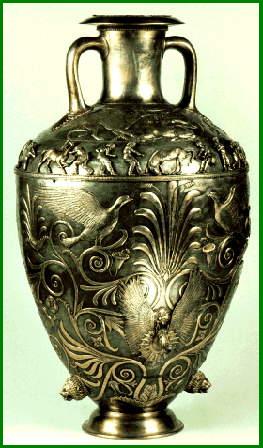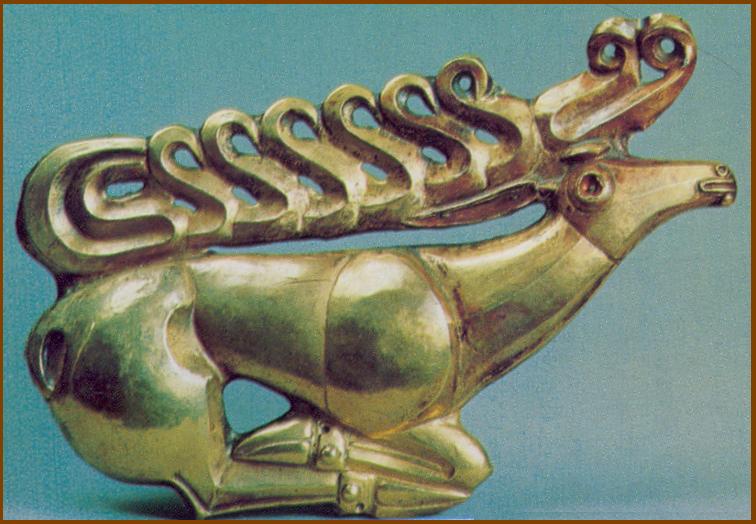
The Scythian and Sarmatian Problems.

The Scythian times were one of the most mysterious periods in the history of Eastern Europe and attracted since long attention of many historians. The recalcitrant question of the origin of Scythians seems to be one of sure key for the ethnogenic studies. However, modern scythology onle lashes the waves. Scientists have repeatedly come back to Herodotus' reports and are continuingly shoveling them painstaking in their works, written sometimes in art form for more convincing becouse of the lack of new ideas (KOLOMOYSKIY IGOR. 2005, MURZIN V.Yu., PETKOV S.V. a.o). Delusions are replicated and reinforced in the minds of young scholars and leads them astray. My works dedicated to the problem of the Scythian (STETSYUK V.M. 1999, STETSYUK. 2000), gone unnoticed in the scientific world, and attempts to interest authoritative experts for them have failed. Under these circumstances, the false representations about the Scythians may exist for decades.
Currently, perceptions of the Scythian culture and language is based on the dominat idea that nomads came from Asia in early Scythian time, populated sparsely populated steppe and spread their cultural influence on the population of the forest-steppe zone of the Northern Pontic Region (NPR). This idea was originally developed out of an uncritical attitude to the ancient historians, especially Herodotus, and plausible at first glance arguments for its confirmation were found. These include the so-called "Scythian triad" (armaments, horse harness and "animal style" in the art), the spread of anthropomorphic statues and burial rites.
This idea was originally developed out of uncritical attitude to notises of ancient historians, especially Herodotus, and for its confirmation were found plausible at first sight arguments. These include the so-called a "Scythian triad" (armaments, horse harness and "animal style" in the art), the spread of anthropomorphic statues and burial rites.
However, the hypotheses scientists have a number of significant differences in such moments, "as the location of the original habitat area of the Scythians and the time of their appearance in the northern Black Sea region, the essence of ethnic and cultural relations between the Scythians and Cimmerians, paths and nature of penetration of both peoples in the Near East, etc." (POGREBOVA M.N., RAYEVSKIY D.O., 1992: 7). It is logical to assume that the common elements of the Scythian culture would have to occur at an earlier stage of its development, but it is not so:
How can we talk about the early Scythian culture, at least on the scale of the Northern Black Sea, while some "Scythian" types are present only in the wilderness, others only in the forest? (Romanchuk Alexey A. 2004, 383).
The apparent incompatibility of certain facts сщьзуды some researchers suggest autochthonous origin of the Scythian culture, or (more often) agree that this culture has been experienced by some local influences, and Scythian ethnos has been arisen as a blend both local European population and people which arrived from the east (Arkheologiya Ukrainskoy SSR. Vol 2. 1986). How much the opinion about the Asian ancestral home of the Scythians is controversial is said by serious attempts to locate it in different parts of Europe. Among the many works of this direction, the monograph of M. Pogrebova and D. Rajewski is really noteworthy. Reasoned criticizing the theory of Asian homeland of the Scythians, the authors suggest the following solution to the problem of early ethno-history of the Scythians:
The scene of the most ancient of any well-known events of this history is not North Pontic Scythia of the Herodotus to the west of the Tanais but the triangle bounded by the lower reaches of the Volga and the Don and the Caucasus range (POGREBOVA M.N., RAYEVSKIY D.O., 1992: 226.)
In fairness it should also be noted that some the supporters of autochthonous origin of the Scythians can express quite extreme views, if the Scythians were the direct ancestors of the Slavs, and even just the Ukrainians (KODLUBAY IRYNA, NOGA OLEKSANDR, 2004). However the Scythians themselves asserted that the first man who settled in the Black Sea, when they appeared in this before desert country, was Targitay. And a thousand years have passed from that time to time to the campaign of Darius on the Scythians (HERODOTUS. 1993: IV, 5,7).

At left: An example of "animal style". Golden figurine of a wild boar from Khomyn kurgan.
A considerable role in forming of the sight about the Asiatic sources of Scythian culture was played by the reasons of certain likeness of relics of Scythian culture with the artifacts of Central Asia. The certain similarity of Scythian artifacts and cultural relics of the Central Asia is the significant argument of the adherents of Central-Asian origin of Scythian culture. Specifically, studying the barrow (kurgan) Arzhan in Tuva, scholars have found out that the samples of the material culture of this barrow can be referred to the Scythian type for they are manufactured in the spirit of the Scythian “animal style”. Since these findings were supposedly chronologically preceded the Scythian culture in the Black Sea, it was confirmed the assumption of its origin in Central Asia, on the advice of M. Gryaznov:
In our opinion the eights – seventh centuries BC were not the end of the Bronze Age and not a transitional or independent ethno-cultural period, but the initial stage of the so-called Scythian epoch of early nomads. This is clearly evidenced by the presence of already well established the Scythian triad in materials of Arzhan (GRIAZNOV M.P., 1980: 58).
Meanwhile, the very method of dating of samples from Arzhan focused on similar findings in the Black Sea, under the assumption of their more recent origin a priori. However, recent discoveries of Ukrainian archaeologists in Early-Scythian burials, similar patterns of Arzhan, specifically relate to former time (KULATOVA I.N., SKORIY S.A., SUPRUNEBKO A.B., 2006: 58). For quite some time many archaeologists came to the conclusion that the sites of the Eurasian steppe belt can not be regarded as a monocultural:
…it is practically not disputed now that the existing similarity between them still can not allow to consider them as belonging to one culture and left by one people (POGREBOVA M.N., RAYEVSKIY D.O., 1992: 37).

At right: An exmample of "animal satyle". The Golden figurine of a deer from the stanitsa of Kostromskaya..
The latest research of archaeologists show that this style has been spread not only in Central Asia. Golden figurines of animals (deer, goats, etc.) like Scythian ones, were found in the Mediterranean, Minor and Central Asia. At the same time, some successful technical solutions (such as elements of horse equipment) could spread throughout Eurasia, according to the way of life of nomads and not be an important an ethno-cultural feature. Explanation of possible causes of similarities between cultures of steppe nomads requires special study of its material samples, for which we have no opportunities, but we can rely on the opinion of scientists, specifically dealing with this issue, in particular, with detailed analysis of items in the collection of a treasure found at Tell Ziwiyeh in Northwestern Iran:
History of the formation of the Scythian animal style as it appears in the light of the above analysis, allows finally to abandon the view that long before the appearance of the Scythian culture in Eastern Europe, it already existed somewhere in the well-established form and that its penetration in the area of occupancy of the Scythians historical time is the result of moving carriers of the culture there. In fact it is formed before our eyes and its different components are formed at different times (POGREBOVA M.N., RAYEVSKIY D.O., 1992: 162.)
There are other facts contradicting the idea of Central Asian origin of the Scythians and their culture. The known anthropologist V. Alekseev stated the following:
Scythians failed to appear in South-Russian steppes from a south-east, how one can think in accordance with the archaeological and linguistic observations, they failed to appear and from a south-west, as compels to think the legend over brought at Herodotus about their origin, but they arose on that place, where they are found by history. Anthropological material does not eliminate the foreign ethnic particulates in the complement of Scythians, however gives primary significance to the local sources of their ethnogenesis (ALEKSEYEV V.P., 1989: 177).
Archaeological evidences also could confirm the cultural continuity Pre-Scythian and Scythian times, but archaeologists have no consensus whether the change of cultures in the steppe part of Ukraine was mechanical in nature or monuments of the Novocherkassk-Chhernogorov type were the link between the preceding Cimmerian and subsequent Scythian cultures. For example:
… where A Terenozhkin finds clear and one-time change of cultures, M Gryaznov sees a direct cultural continuity (POGREBOVA M.N., RAYEVSKIY D.O., 1992: 36).
Ambiguity of the question about cultural continuity in the steppes of northern Black Sea region leads to the fact that even the supporters of the Asian origin of the Scythian culture there have no consensus on the issue when the aliens brought it from Asia. Here's one of the views:
Archaeology does not know about any invasion of the nomadic population in the northern Black Sea region, which could correspond to the appearance of the Scythians and the expulsion Cimmerians, after… the spread of the Zrubna culture to the west of the Volga and the displacement of the preceding Catacomb culture, however it does not refer to the 8th -7th centuries BC but to much former time – the last third of the 2nd millennium BC. In view of this, the base of the event referred by Aristaeus and Herodotus may have just change of the Catacomb culture by the Zrubna one, corresponding to the replacement of one people by another, namely, the Cimmerians by the Scythians (ARTAMONOV M.I., 1974: 13).
Clearly, M. Artamonov saw continuity between the Cimmerian and Scythian cultures, assuming both of them belonged to the Scythians. The same opinion except the aforementioned M. Gryaznov had also A. Jensen and, obviously, other archeologists (POGREBOVA M.N., RAYEVSKIY D.O., 1992: 36). A. Terenozhkin same, denying such succession, believedhat the Novocherkassk-Chernogorov relics belonged to the Cimmerians, and the creators of the Scythian culture were "people who came from the depths of Asia, who succeeded in the 7th cen BC their predecessors – the Cimmerians, aboriginal native of southern European part of the USSR" and that "the Scythian culture was introduced from the outside in a well-established appearance and if mechanically replaced the old local culture" (TERENOZHKIN A.I., 1976: 19). Artamonov’ theory is contradicted by historical facts, since the conflict between the Scythians and Cimmerians was recorded by ancient and east historians and its reason was associated with the invasion of the Scythians, and the dating of these events was separated from the change of the Catacomb culture by Zrubna one on about 500 years later. By the way, given historians did not know anything about the Scythians in the depths of Asia, they considered them immigrants from Eastern Europe, which is also not in favor of the Terenozhkin’s theory.
As Ilyinski and Terenozhkin established, the transition to the Scythian period occurred on the Right Bank of the Dnieper River in the course of the evolution of culture of Jabotinsky type approximately in the middle of the 7th century BC. It is very important a fact that most of the early Scythian time sites are found in the forest-steppe up to the Right Bank Forest-steppe yill the Upper Dniester. There are in the steppes, where Scythian culture flourished later, only few tens of Early Scythian burials of previous period. (ROMANCHUK ALEKSEY. 2004: 375).












